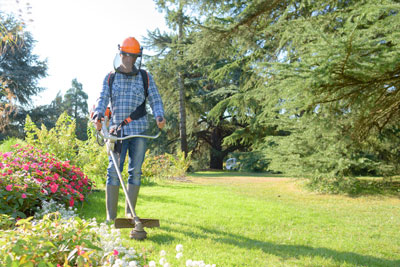Technology affects every aspect of our lives, at work and play, and for the recreation industry, both work and play simultaneously. For everything from audio and lighting systems to aquatic center water quality equipment to software that streamlines office work, advances in the past two decades have helped managers, operators and organizations work smarter and save money in their quest to provide health and wellness to their communities.
Sometimes, tech can help save the planet as well. Jerry Hernandez, director of maintenance and planning for the Lemont (Ill.) Park District, said software played a major part in convincing the town’s administration to switch from granular salt to salt brine, a more environmentally beneficial form of road salt.
“While I know it is our responsibility as a public entity to help by doing our part to reduce pollution, people in my position need a way to communicate that to the public and our final decision-makers that we report to,” Hernandez said. “I used our work order software to directly track quantities of granular sodium chloride applied and was then able to show the difference of sodium chloride used with salt brine. I was able to do this through work order tasks, inventory and then reporting on each through our work order/asset management software.
“We were able to present to our board of commissioners at the time a comprehensive plan for our district to do our part with the environment. These real numbers and facts helped justify the upfront cost to implement the salt brine equipment. Five years later, the district is almost exclusively using salt brine instead of granular product, reducing its chlorides pollution by 70%. On a side note, ArcGIS was used for mapping out snow operations routes and square footage for application rates.”

During his 12 years in the parks and rec field, Hernandez said he has used technology in many applications, including staff scheduling, equipment replacement schedules through asset management software, BAS (building automation and control systems) for facilities automation and trending, work order software for operations work scheduling and record keeping, work order software for inspections, work order software for preventative maintenance schedules, SCADA systems for aquatic facility operations, and GIS for mapping and tracking assets including tree inventories, amenities and underground infrastructure.
Hernandez said the cost of purchase and implementation is usually paid for quickly in both time and money savings. “There are many times when a part-time employee will be on-site and see something that might be wrong and because of technology, we have been able to remotely see and correct the issue without calling in staff,” he said. “Other examples would include work order software to efficiently manage staff labor loads or having automatically generated equipment replacement schedules and depreciation values.”
There have been misfires, said Hernandez, such as BAS systems that lacked communication points, leaving out valuable information; software that has required extensive learning curves to operate; work order software that was too time-consuming for the end user; and some software that is simply too expensive. He recommends due diligence when searching for software.
“Don’t get too excited about the newest shiny object,” said Hernandez. “Make sure you evaluate to ensure that it is user-friendly, that the cost of the new software creates long-term cost savings, and make sure the customer support will be responsive. I think the biggest thing for me in my long-term wish list would be that more software programs are open and effective at communicating with other software programs.”
Savings can also be measured in fewer headaches and frustration, said Gio Santana, superintendent of parks and recreation for Aurora (Ill.). Santana said before the switch to software, “it was very cumbersome, very outdated, a lot of pen and paper, notepads for daily tasks.
“Communication was all over the place—verbal communication, text, emails,” he said. “This has really helped hone in on that and kind of centralized all the information in the software. I’m not a big fan of collecting papers from everybody and researching all the way through it and building spreadsheets to organize it, so it makes sense to have a software that’s meant to do that.”
Santana said ease of implementation should be vetted because the fear of difficulty should not be an obstacle to tools that ease the load of bosses and their employees. “Honestly, with how easy it was, I wish we would’ve done it a lot sooner,” Santana said. “Part of that was on me specifically just looking at the daunting task of, we have to get this uploaded, we have to get everything implemented, get everything online.
“Being able to give them the information—here’s our list of parks, here’s your inspections, this is the type of stuff we need, here’s a list of our equipment—just made it really seamless and very pain-free. So I really wish we would’ve just done it a lot sooner.”
Savings in money and time are the main benefits, and staff happiness is not far behind, Hernandez said of the selection process for one software product his office uses. “One of the big selling points for me was the end user,” he said. “The staff out in the field—you don’t want them filling out paperwork all day about what they’re doing. It needs to be efficient. So that was a big part of it. And then also the ease of use, and it does everything else pretty much every software does as well. It’s just a lot more fluid for staff.”

The tasks technology helps with can be mundane but impactful. Santana said his use of a garbage collection software will most likely result in savings close to six figures by not having to replace the current garbage truck. Software that keeps track of tree inventory helps in several ways, he said. “The tree inventory really gave us a clear road map for not only prioritizing work, but also gave us a good snapshot of how many trees, what type of trees, and better direction for what should be planted and shouldn’t be in certain areas,” he said. “We are also working on a component to incorporate QR codes so that people can do self-guided tree tours.”
While technology certainly makes life easier and less expensive for staff, that peace of mind and savings trickles down to the community users, said Kevin Gruzewski, implementation manager for a Lombard, Ill.-based company that provides software to help park districts with maintenance. Assets like parks, playgrounds, facilities and aquatic centers are the backbone of recreational programming, and if those assets aren’t properly cared for, they can become unsafe, unsightly or break down, he said.
“By conducting regular inspections, completing preventive maintenance and addressing small problems before they become bigger, more expensive issues, maintenance teams help keep parks and recreation assets in the best possible shape while giving the public positive, valuable experiences,” said Gruzewski. “We help maintenance managers automate some of their processes, like assigning scheduled tasks, implementing maintenance plans, monitoring assets, managing work orders, and generating custom reports for short- and long-term strategic planning.”
Gruzewski said a good tech provider thrives on user feedback to improve the product and tailor it to specific needs. “One of the key things we learned working with several agencies is that there is not a single right answer on how to do things,” he said. “Every parks and recreation agency is unique. We’ve seen maintenance teams work in many different ways. Prior experience working in the field and developing maintenance management solutions has taught us that software has to be just as flexible as the teams it serves. We often tell our customers that if something they are doing with the software is not working for them, there is likely another way to approach it that may resonate more.”
Customization is at the heart of what Kevin Post’s firm does when helping aquatic facilities with their technological demands. Air and water quality are mandatory for the safety of all indoor competitive and recreational pools and waterparks, and technology has vastly improved the maintenance of both. His company helps with:
- Automated Systems: Advanced controls for water treatment, filtration and energy management now allow for real-time monitoring and automated adjustments, improving efficiency and reducing manual oversight.
- Smart Sensors and IoT: Integration of sensors and IoT technology enables continuous monitoring of water quality, temperature and facility conditions, providing valuable data for maintenance and operational adjustments.
- Energy Efficiency: Innovations in heating, ventilation and air conditioning (HVAC) systems, as well as water heating and conservation technologies, have significantly improved energy efficiency and sustainability.
- User Experience Enhancements: Modern aquatic facilities incorporate features such as interactive play elements, enhanced lighting and advanced safety systems to improve the overall experience for patrons.

Post said several challenges can hinder the adoption of new technologies in the aquatic industry. There may be a resistance to change with facilities accustomed to traditional methods reluctant to adopt new technologies due to perceived risks, costs or disruption. Integration issues can arise when incorporating new technologies into existing infrastructure, particularly when retrofitting older systems. There are cost concerns as the initial investment required for advanced technologies can be a barrier for some facilities, despite the long-term savings and benefits.
“Overcoming these challenges involves demonstrating the tangible benefits of new technologies, such as cost savings, improved efficiency and enhanced user experience,” said Post. “Providing robust support and clear, data-driven recommendations helps facilitate smoother transitions.”
The future of aquatic technology is geared toward further advancements in several areas, said Post: the use of artificial intelligence and machine learning for predictive maintenance, operational optimization and user experience personalization is on the horizon; continued focus on energy-efficient systems, water conservation technologies and eco-friendly materials will drive further improvements in sustainability; future developments may include more interactive and immersive recreational features, as well as improved safety and accessibility technologies.
“We are actively exploring these emerging trends and incorporating them into our designs,” he said. “Our commitment to innovation ensures that our clients benefit from the latest advancements, positioning their facilities at the forefront of the industry.”
Craig Ellingson, parks operations manager for the town of Windsor, Colo., has used a lot of technology in his 20 years in the industry and said he has evolved along with it. His department’s successful use of robotic painters for field lines has him exploring the viability of robotic mowers.
“What took four to five staff all day long to do, we can now do with one staff member in half the time,” Ellingson said of the painters. “The other staff now can focus on other tasks in parks that they would not have had the time to do otherwise.”
Ellingson said his only bad experiences with tech have been not with faulty product but with bad fits for the staff or tasks. He said his most important lesson over the years has been not only trying to ensure compatibility but not being afraid to move on to something new after a trial period.
“The best tech is not always the best tech for everyone,” he said. “Each organization needs to find what works best for them even if it is not touted to be the latest and greatest. Get buy-in from the line staff to make sure the tech is really something they will use. If they like it and want it, they are more likely to use it; then you have their investment in the tech.
“Sometimes tech you think is really good and will benefit the organization doesn’t pan out like you had hoped. Don’t be afraid to abandon it to try something new. Now, that doesn’t mean the first time it fails you kick it to the curb, but if it is just not the solution for you and there are more negatives than benefits, why keep it around? We get so scared to leave something we have invested time and energy in that we miss opportunities to find something that might truly work better and make our operations more efficient.”
From the provider side, Camron Cutler agrees with Ellingson on the most common challenges. “Change can be tough, especially if you’re used to manual processes or legacy system,” said Cutler, a senior product manager for a Pennsylvania-based provider of asset management software. “We tackle this by showing how upgrading to modern tools can lead to better reliability, smarter resource use and data-driven decisions that really make a difference.”
The way technology has helped in the office and in the field is matched by how it aids the operation and maintenance of equipment. Some of the most expensive recreation operations are in aquatic facilities, and one of the most basic ways technology has evolved to help is in chemical control.
A chemical controller ensures pools get the proper amount of chemicals at the proper times, said Dave Button, vice president of business development for a Santa Barbara, Calif.-based provider of chemical controllers. “When you hand feed, it is common to overfeed chemicals to make it last until you can hand feed again,” he said. “A chemical controller will also help extend the life of other equipment, which will save the facility money. It also reduces labor because there’s no need for staff to load chemicals.”
In his career in recreation, Santana has learned a few things about when technology is needed and how to best search for it:
- Do your research, ask around, call up others in your field. “Good chance that something you wish would exist actually is already a thing or close to development,” he said. “There is a plethora of resources out there, and I think it’s very easy to fall into the trap of not wanting to be a burden or not wanting to ask for help. Chances are there are others facing similar challenges or looking for similar solutions, so work together.”
- Work with the experts. “Our internal IT department is great about working with us and getting an understanding of what our needs and goals are and working with us to find those solutions,” said Santana.
Ellingson said it’s important to not overlook the human element. “Training is key. Staff are only as good with tech as they are trained in it,” he said. “Always keep learning the tech and how it can improve operations.”
That human element extends to providers and their bedside manner with clients, Ellingson said. “In my experience, the best companies are the ones that listen to their customers and make modifications based on real-life application and not just stick to what they as a company think is best but what really does serve the end user the best,” he said.
“I will take a company that is willing to learn, grow and adapt to the user group rather than a company that says, ‘This is our product, take it as it is, and we don’t tailor it to meet our end users’ needs.’ This takes patience on our end, and the company adapts to the needs of the user.” RM



